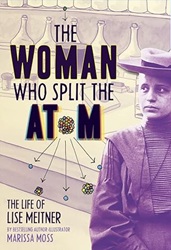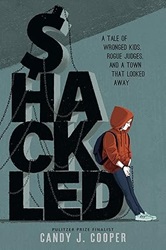Review of The Woman in the Moon, by Richard Maurer
How Margaret Hamilton Helped Fly the First Astronauts to the Moon
by Richard Maurer
Roaring Brook Press, 2023. 254 pages.
Review written December 15, 2025, from a library book.
Starred Review
It’s always good to read about a female mathematician who excelled in her field. Margaret Hamilton studied math in the 1950s and learned computer programming while working with the meteorologist Edward Lorenz, who discovered the Butterfly Effect in meteorology. Margaret ran his computer simulations at MIT, and later moved to the lab that worked on the computer software that would go into space with the Apollo missions. Margaret, in fact, was the person who coined the term “software engineering” to reflect that writing the computer code was as much a feat of engineering as constructing the wiring – though in fact some of that code was wired into the physical computers.
This book takes us through Margaret’s life as she was consistently the only woman in her field. It goes into lots of interesting detail about the Apollo missions, all that they were up against, and how Margaret was responsible for making the software work. An abundance of relevant photos help keep the text moving, and the whole thing captures the sense of wonder that humans actually made it to the moon – with 1960s technology.
Historians believe a key reason that American astronauts got to the Moon first (Soviet space travelers never got there at all) was America’s lead in computer technology. There were computers at the launch center, computers at Mission Control, computers at the contractors, computers at the tracking stations, and of course the miniature AGC in the spacecraft. Among all these electronic brains, the only computer that never failed was the AGC. In thousands of hours of manned spaceflight, no software errors were known to have occurred. The achievement is unique in computer history. “Nobody can believe it to this day,” Margaret noted.
Margaret was the one in charge of the software for the AGC, the Apollo Guidance Computer, which was in the command modules in flight. This was a behind-the-scenes job, so it’s good to see this entire book about her, giving some much deserved recognition (besides the Presidential Medal of Freedom she got in 2016). Now kids and teens can learn about her accomplishments.
This book is geared to a middle school audience, but there’s nothing in it that would make high school students feel it’s too young for them, so I decided to post this review on my Teen Nonfiction page instead of my Children’s Nonfiction page, even though in the library we have it as a Juvenile Biography. It’s at a much higher level than the many picture book biographies I post on that page. aLearn about the woman who wrote the software that got humans to the moon.
Find this review on Sonderbooks at: www.sonderbooks.com/Teen_Nonfiction/woman_in_the_moon.html
Disclosure: I am an Amazon Affiliate, and will earn a small percentage if you order a book on Amazon after clicking through from my site.
Disclaimer: I am a professional librarian, but the views expressed are solely my own, and in no way represent the official views of my employer or of any committee or group of which I am part.
Subscribe for more reviews and talk about books.
Join the conversation: What did you think of this book?









